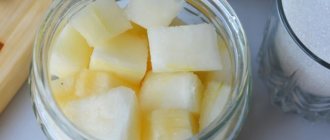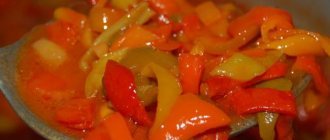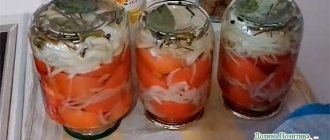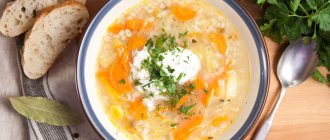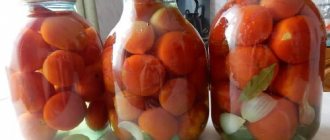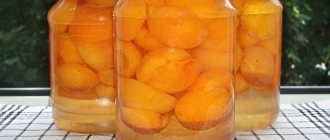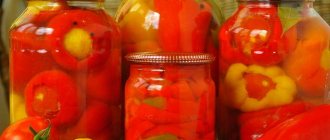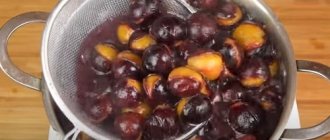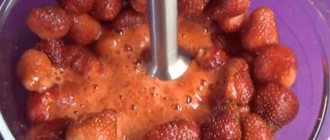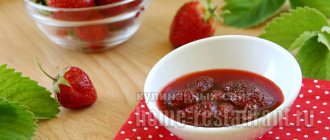How to use strawberry syrup
Strawberry syrup, prepared at home, is added to porridge, curd mass, puddings, creams for cakes and pastries, carbonated drinks such as lemonade, fruit drinks, ice cream, marmalades, jellies, cruchons, fruit salads and other dishes and drinks.
Alcoholic and non-alcoholic cocktails with strawberry syrup are very tasty, for example, dessert with ice cream.
Decorate the cocktail with whipped cream and serve.
Strawberry syrup is an excellent base for preparing many desserts: such a product will not stagnate in the refrigerator or kitchen cupboard. As for storage, in room conditions the sweet strawberry preparation lasts for about six months, in a cool, dry place such as a cellar - up to 12 months.
Making syrups from berries or fruits ripened in the garden is an excellent choice of preparation option. Concentrated berry and fruit syrups have always been popular among housewives, despite the fact that fragrant and juicy natural gifts are perfectly preserved for future use in the form of preserves, jam, marshmallows and other sweet preparations. But knowledgeable housewives still willingly cook sweet and healthy syrups, the preparation of which, as a rule, does not require much time. The thick, concentrated liquid is popular in cooking all over the world. They are used to enrich drinks, baked goods and various desserts. In addition to ordinary fruits and berries, experienced chefs prepare syrup from rose petals, mint leaves and other herbs. Step-by-step recipes with photos will help you quickly and easily learn the simple secrets of making tasty and healthy syrup at home.
The last notes
Plum bushes and trees usually produce a very good harvest. Gardeners cope with the abundance of berries by storing them for the winter. In addition to the usual compotes, preserves and jams, very tasty syrup is prepared from plums. For culinary purposes, it is used as a sauce for pancakes and baked goods, as well as a filler for refreshing cocktails. We will talk about all the ways to prepare this dessert at home in this article.
Syrups
– these are sweet preparations from fruit and berry juices thickened with granulated sugar (the share of sugar in the preparation is from 65%). At home, they can be preserved with the addition of tartaric or citric acid.
The preparation of sweet fruit and berry syrups is carried out using hot and cold methods. Whichever option is chosen, an important condition is thorough sterilization of the container. The sterility of the dishes will ensure long-term preservation of the workpiece.
Regardless of the chosen recipe for creating syrup, it should be taken into account that the fruits for preparing the preparation must be of high quality - ripe, without obvious signs of spoilage, with a pronounced aroma and taste. In addition, it should be borne in mind that the juice from which the syrup is planned to be prepared cannot be stored, that is, it must be exclusively fresh.
The range of applications for fruit and berry syrups prepared for the winter is wide. They can be used to soak cake layers, to prepare various cocktails, to complement ice cream and other desserts.
If you are planning to prepare and store fruit or berry syrup for the winter, then one of the step-by-step recipes with photos in this section will help with this. Exactly following detailed instructions with illustrated pictures is the key to obtaining a delicious product.
- Syrup from chokeberry (chokeberry) for the winter
- Blackcurrant syrup for the winter
Red currant syrup is a fairly popular preparation for the winter, which is perfectly stored both in the cold and at room temperature. In the refrigerator, the syrup thickens and turns into a light jelly.
However, unlike many other recipes for similar homemade preparations for the winter, this one is good because the syrup is not heat-treated. In other words, we get a berry syrup that is 100% filled with the original vitamins, minerals and other benefits.
Serve ready-made redcurrant syrup with pancakes and pancakes, use it in homemade baking, make desserts based on it, dilute with water and drink as a compote. Fragrant, rich and very tasty redcurrant syrup is one of the best preparations that I make every year for my family. And I recommend it to you!
Cooking the dish step by step with photos:
I don’t like this task of sorting and washing red currants, but I have to. We need juice, so we pick the berries from the branches, rinse the currants and put them in a sieve to drain. I know that some chefs are not particularly scrupulous about this procedure - they squeeze the juice from the currants directly with the branches. I don’t like it that way, so berries are better. We weigh the red currants - just for fun. You are wondering how much juice was obtained from such and such a number of berries. I had exactly 4 kilograms - I collected it myself.
Using a juicer we obtain juice. It will turn out cloudy, with a huge amount of foam - that’s how it should be. By the way, again, some housewives squeeze the berries through cheesecloth, but I am not capable of such a feat (last year I had enough grape juice, which burned my hands for a day).
We collect all the juice in one container, and also strain the pulp (it also contains a fairly decent amount of juice) into the same container. Now you need to leave the red currant juice in the refrigerator overnight if you squeezed it in the evening. In general, for 8-10 hours, so that the foam rises, thickens and comes off easily.
We pour this dense foam into a fine sieve to get more juice. I won’t tell you where to use it, I just throw it away. But can anyone suggest recipes for using such a berry cap?
Now we filter the red currant juice again so that it is completely transparent, without a hint of cloudiness. And we weigh it. From 4 kilograms of fresh berries I get 1 liter of 800 milliliters of juice. This means we need exactly the same amount of sugar (maybe a little more, but not less).
Add sugar and mix it. You can use a spoon, but it will take so long, or better yet, with a mixer - the crystals will immediately begin to dissolve.
"Crumpled Pig"
For this recipe, you can use overripe apricots, as well as those that have lost their elasticity. But this will not affect the taste in any way, but will only make it richer.
You will need:
- apricots;
- lemon acid;
- granulated sugar;
- everything you need for conservation.
Proportion: 1 part apricot = 1 part sugar + acid on the tip of the knife.
How to do it:
- Place apricots, divided into slices, into a large bowl. They don't have to be even.
- Cover them with sugar and leave for a couple of hours. This is necessary so that they release juice.
- Now put it all on low heat and let it boil.
- After boiling, reduce the heat to low and cook for about an hour and a half.
- The foam head must be removed until it stops flowing.
- The jars for this recipe are thoroughly washed and sterilized.
- Fill the container with apricots and hot syrup, roll it up and leave to cool.
How to cook syrups with water
I’ll immediately specify the necessary requirements for preparing syrup recipes. We prepare syrups for the winter from juicy, ripe and overripe fruits and berries, cook over high heat. To keep them light, add sugar when some of the juice has evaporated (unless otherwise required by the recipe).
While boiling, skim off the foam. Add tartaric or citric acid 3-4 minutes before finishing the recipe. We do not add any essences (do you need it, this chemistry?). Add citric acid, stirring vigorously, in small portions to avoid splashing (or dissolved in a very small amount of water).
We determine the thickness of the syrups by checking the cooled drop in a glass of cold water. If it falls to the bottom and dissolves when stirring, the syrup is ready. If it dissolves as you go, it means it’s not thick enough yet.
Be sure to pour the finished product hot into heated, dry glass containers, which we seal after cooling and store it in a cool room.
Ingredients:
- cherry – 3 kg,
- sugar - 1.5 kg (per 1 liter of juice obtained),
- water - 5 glasses,
- lemon - 1.5 teaspoons.
Peel the cherries, wash them and crush them by hand without removing the seeds. We stand for a day.
Pour in water, mix thoroughly, strain through double gauze. Having received the juice, let it stand for several hours and filter again to remove the sediment that has formed.
Based on the resulting volume, add sugar in proportion and cook, skimming off the foam with a slotted spoon, until the required thickness.
Ingredients:
- strawberries - 1 kg,
- sugar - 0.6-0.7 kg,
- water - 1 glass,
- lemon - 0.5 gr.
We sort through, removing the stalks, and wash the strawberries. Place in an enamel or porcelain bowl, add sugar and leave for a day. Strain through cheesecloth.
Add water to the juice and cook in a small container.
Ingredients:
- strawberries - 1 kg,
- water - 1 l,
- sugar - 1.5 kg.
Place the prepared strawberries in an enamel or glass container and, filling them with water, place them in a cool place for a day. Then we cover the dishes with gauze and strain the juice until the end, without squeezing the berries.
Add sugar to the juice, stirring, heat and, after the sugar has completely dissolved, quickly bring to a boil.
Ingredients:
- strawberries - 1 kg,
- sugar - 0.6 kg,
- water - 0.35 l.
After boiling the sugar syrup, cool it and pour in the peeled strawberries. Bring to a boil, boil for 2-3 minutes and put in a cold place for 24 hours. We express the juice through cheesecloth without squeezing the berries. Bring the juice to a boil and, after removing the foam, pour it hot.
We seal the jars hermetically and, wrapping them in a blanket, let them cool.
We use the remaining berries for jam and marmalade.
Ingredients:
- raspberries - 1 kg,
- sugar - 1 kg,
- water - 1 glass.
Prepare sugar syrup. Place raspberries in it, bring to a boil, skim off the foam and leave to cool.
Strain the cold mixture and bring to a boil. Continue cooking for about 5 minutes. Remove the foam and pour.
Ingredients:
- red currants - 1 kg,
- cold, boiled water - 2 cups,
- sugar - 2 kg (for each liter of juice obtained),
- lemon - 1 teaspoon.
Wash the currants, remove the twigs and debris, mash them, pour in boiled water, mix thoroughly, and strain through a thin cloth.
Add the required amount of sugar to the resulting juice and stir. Cook, add lemon at the end of the process.
Ingredients:
- rose hips and sugar - 1 kg each,
- water - 1.2 l.
Remove the seeds from the rosehips, wash them thoroughly and grind them in a meat grinder. Pour half a liter of water and boil for 10 minutes. Then add 60% syrup (7 cups of sugar) and cook again for 15-20 minutes. Strain through a sieve and pour.
The resulting syrup is used to prepare various dishes and drinks. And we put the squeeze into the filling and seasonings.
Ingredients:
- oranges - 4 pcs,
- sugar - 2 kg,
- water - 5 glasses,
- tartaric acid - 2 teaspoons.
Using a fine grater, remove the zest from the oranges (do not throw away the zest). Place the peeled oranges in a suitable container, add a glass of water, adding 1 teaspoon of tartaric acid. Let stand for 1 hour. Squeeze the orange juice and strain it.
Pour sugar with water, bring to a boil, pour orange juice into the syrup, add zest and cook for 6-7 minutes. Strain through a thin cloth and cook. At the end, pour in 1 teaspoon of tartaric acid.
Ingredients:
- berries - 1 kg,
- sugar - 0.5 kg,
- water - 1 glass.
We sort out the blackberries, wash them, squeeze out the juice, add sugar and water, boil for 5-10 minutes and pour into bottles. Cover tightly and place in a cool place.
We cook halves (slices) of apricots in syrup with sterilization for the winter
This method differs from the first option in the final stage - sterilization. Therefore, we will prepare apricot compote in small 0.5 liter jars. It is more convenient to place them in a saucepan for boiling.
Ingredients for a 0.5 l jar:
- apricots
- 100 g - granulated sugar
- Wash the apricots thoroughly. Then, cutting it in half lengthwise, remove the seeds. Place the fruit halves cut side down (to allow more juice to pass through) into jars. Sprinkle them with granulated sugar in layers and on top.
- Leave overnight for the fruit to release its juice. In the morning, sprinkle with sugar again and add halves of fruit so that the jars are full.
Approximately half a glass of sugar goes into a half liter jar. But you can adjust the amount of sweetener to your liking.
- Place the jars in a wide pan with a cotton cloth on the bottom. Fill with warm water so that the jars are covered up to their shoulders.
- Simply cover the top with lids (not tightly!) and after boiling, sterilize for 20 minutes.
- 5 minutes before the end of the procedure, open the lids slightly and check that the juice reaches the top of the jars. If it is not enough, add water.
- Remove the jars from the pan and screw on the lids. Turn them over and put them under the blanket to cool for 24 hours. Then you can put the blanks on the shelf with other twists.
